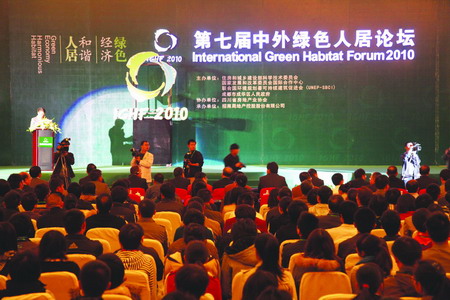Business
Green living: people-oriented, but everyone has to participate
By Zhang Zhao (China Daily)
Updated: 2010-11-26 07:57
 |
Large Medium Small |
|
 The 7th International Green Habitat Forum, in Chengdu, Sichuan. [Photos Provided to China Daily] |
We are the ones who decide what green is
The green habitat model that was on view recently at the 7th International Green Habitat Forum (IGHF 2010) in the city of Chengdu, Sichuan province, is not just about more plants and a better environment, according to a World Wildlife Foundation official.
It is a people-oriented idea involving all aspects of life, which needs everyone's participation. And it has a direct impact on the building industry, said Yang Fuqiang, director of Global Climate Solutions at the World Wildlife Foundation, who took part in the forum, which ended on Nov 3.
"To understand the concept of a green habitat, one easy example is that of building a residential community," Yang said.
"It is fundamentally a people-centered orientation. Property developers are not just selling houses, more importantly, they're providing services," Yang explained.
"In building a community, the planners have to take into account what the people need. For example: low-carbon houses, green belts, pipelines, wiring and cable networks, and other facilities like kindergartens, schools and hospitals."
"In larger, more modern communities, there can also be man-made wetlands and water treatment facilities."
While there may be few mandatory government rulings on this, many leading real estate companies are making an effort to develop green technologies, Yang noted.
One example of this is the Vanke Co Ltd, one of China's largest property developers, which has its own individual garbage collection system.
The use of advanced green technology can give developers a competitive edge and promote a company's name.
In spite of the extra costs involved in going green, house buyers will see no sharp increase in prices, Yang said.
"With a several hundred yuan increase per square meter, green residential communities are still very attractive to house buyers," he said.
However, while low-carbon, eco-friendly cities can indeed be built out of green communities, China faces its own problems, which are different from those in Western countries.
"Western countries have a long history of urban development, and cities there have solved their air pollution, water shortage and heavy traffic problems, one by one. But China is running into these problems all at the same time."
China needs to improve its urban planning, transportation, and industrial structure with a circular economy that focuses more on energy efficiency, according to Yang.
He said he believes that city planners should "pay more attention to what's underground than what's aboveground".
By "underground", Yang means a city's infrastructure, including the piping, cables, drainage system, electric power, and communication networks necessary for the normal running of a city.
This underground stuff in many Chinese cities was poorly planned, he continued.
"We've often heard stories about a water pipe cracking or something somewhere that's jammed, or an electric power cable that's damaged by construction workers because they didn't even know it was there."
In addition, a low-carbon, eco-friendly city needs a competitive edge - a high employment rate, Yang said.
And it needs feelings of happiness, which are tied to low-carbon features.
"This is easy to understand. When you wake up in the morning and look out the window and see only hazy air, and traffic jams everywhere, you cannot be in a good mood."
People are a necessary part of building a green habitat, Yang concludes.
"While leading companies make standards, it's the customers who make the choices. They are the final judges and graders."